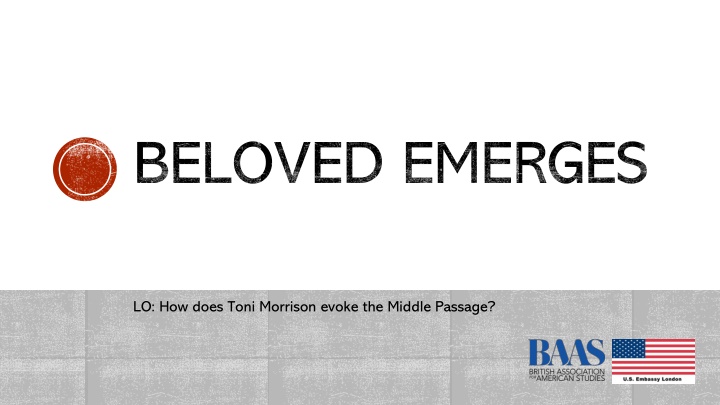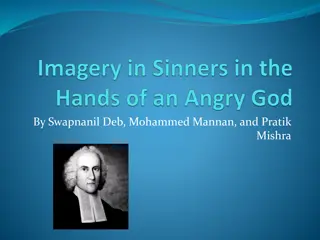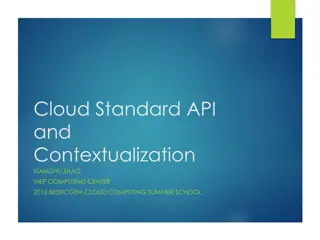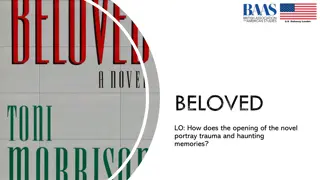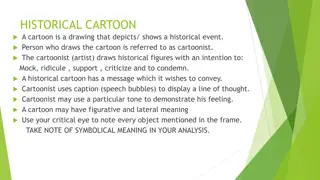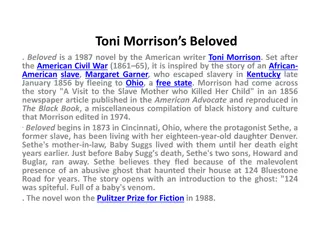Examining Water Imagery in Toni Morrison's "Beloved" and Its Contextualization with Historical Events
Toni Morrison skillfully evokes the harrowing Middle Passage experience in "Beloved" through water imagery, symbolizing themes of cleansing, rebirth, and trauma. By comparing the water symbolism at various points in the novel, readers can explore its significance in relation to historical events like slavery, emancipation, and the Great Migration. Morrison's adept use of supernatural elements adds depth and authenticity to the narrative, inviting readers to ponder the blurred boundaries between reality and the spiritual realm, with parallels to the Haitian Vodou believe in Erzulie, echoing themes of liberation and cultural heritage.
Download Presentation

Please find below an Image/Link to download the presentation.
The content on the website is provided AS IS for your information and personal use only. It may not be sold, licensed, or shared on other websites without obtaining consent from the author.If you encounter any issues during the download, it is possible that the publisher has removed the file from their server.
You are allowed to download the files provided on this website for personal or commercial use, subject to the condition that they are used lawfully. All files are the property of their respective owners.
The content on the website is provided AS IS for your information and personal use only. It may not be sold, licensed, or shared on other websites without obtaining consent from the author.
E N D
Presentation Transcript
BELOVED EMERGES LO: How does Toni Morrison evoke the Middle Passage?
BELOVED EMERGES Read p. 60 Read p. 60- -67 67 How would you interpret the water imagery here? How does it compare to other times when How would you interpret the water imagery here? How does it compare to other times when the motif of water was important? the motif of water was important? - - Water to wash chamomile off Water to wash chamomile off Sethe Sethe at the beginning of the novel at the beginning of the novel - The water of the Ohio river The water of the Ohio river
HOW CAN WE CONTEXTUALIZE BELOVED (P. 63)? Recap: Recap: The Emancipation Proclamation in 1863 freed African Americans in rebel states, and after the Civil War, the Thirteenth Amendment emancipated all U.S. slaves Thirteenth Amendment emancipated all U.S. slaves wherever they were. Former slaves in the South now were a free people Former slaves in the South now were a free people surrounded by many hostile whites. surrounded by many hostile whites. One freedman, Houston Hartsfield Holloway, wrote, For we colored people did not know how to be free and the white people did not know how to have a free colored person about them. The Reconstruction Reconstruction implemented by Congress (1866 1877) aimed to reintegrate the Southern States into the Union and define how whites and blacks could live together in a nonslave society. The South, however, saw Reconstruction as a humiliating. States enacted a series of laws known as the Black Codes, Black Codes, which were designed to restrict freed Black peoples activity and ensure their availability as a labor force. Education was considered a main tool of freedom Education was considered a main tool of freedom - During the years after the war, black and white teachers from the North and South, missionary organizations, churches and schools worked tirelessly to give the emancipated population the opportunity to learn. By 1877, By 1877, when the last federal soldiers left the South and Reconstruction drew to a close, Black Americans had seen dishearteningly little improvement in their economic and dishearteningly little improvement in their economic and social status social status, and what political gains they had made had been wiped away by the vigorous efforts of white supremacist forces throughout the region and violent groups such as the Ku Klux Klan The early stages of the Great Migration The early stages of the Great Migration During Reconstruction freed slaves began to leave the South. This culminated in the relocation of more than 6 million African Americans from the rural South to the cities of the North, Midwest and West from about 1916 to 1970. To what extent is the supernatural made To what extent is the supernatural made believable and authentic here? How does believable and authentic here? How does Morrison achieve this? Morrison achieve this?
SPIRITUAL CONTEXTS: BELOVED AS ERZULIE? Which characteristics of Which characteristics of the different emanations the different emanations of of Erzulie Erzulie does Beloved does Beloved embody? embody? Erzulie Erzulie is a religion religion of of Haitian Vodou. Haitian Vodou. is a Lwa Lwa (also loa (also loa or or loi loi) ) a spirit in the African diasporic a spirit in the African diasporic Voudon Voudon (Haiti), also known as (Haiti), also known as Voodoo, or of Haiti with West African roots versions of this are / were also practiced in the Southern US; The primary goal and activity of Vodou is to sevi lwa ( serve the spirits ) to offer prayers and perform various devotional rites directed at God and particular spirits in return for health, protection, and favour. Spirit possession plays an important role in Afro-Haitian religion, as it does in many other world religions. Voodoo, or Voudou Voudou, is the national folk religion Erzulie Erzulie: : The Erzulie is a family of loa that are often associated with water (fluidity), femininity, and feminine bodies. The three main emanations are: Erzulie Erzulie Fr da dancing, luxury, and flowers. Her symbol is a heart, her colors are pink, blue, white and gold, and her favorite sacrifices include jewelry, perfume, sweet cakes and liqueurs. Coquettish and very fond of beauty and finery, Erzulie Freda is femininity and compassion embodied, yet she also has a darker side; she is seen as jealous and spoiled and within some Vodoun circles is considered to be lazy. Fr da Dahomey: Dahomey: Haitian African spirit of love, beauty, jewelry, rzulie rzulie Dant r chromolithographs with the Mater Salvatoris, often depicted as a fearsome black woman. She is a particularly fierce protector of women, children and the neglects of society. In contrast to rzuli Freda who will bless you with material riches, rzulie Dant r will give you the Spiritual Knowledge needed to navigate through this material reality Dant r: : the black woman of passion identified in Catholic Erzulie Erzulie- -Ge specific historiography of women's experience in Haiti and throughout the Caribbean. A reckless, fearless spirit who fought during Haiti s war for independence, and is often inarticulate Ge- -Rouge: Rouge: the cold-hearted, savage, vengeful, she dramatizes a
WHY ARE THESE SPIRITUAL CONTEXTS SO IMPORTANT? Cultural identity: Cultural identity: Alongside other folk traditions, these beliefs not only gave collective strength, but preserved the histories ignored, denigrated, or exoticized by the standard, "imperial" histories. It was the survival of these customs and gods that provided continuity for the dispossessed. continuity for the dispossessed. Key word: Syncretic Key word: Syncretic Describes Describes the combination or fusion of combination or fusion of different forms of belief different forms of belief or practice or practice the Thinking differently: Thinking differently: Unlike Western religions that depend upon Western religions that depend upon dualisms dualisms such as matter and spirit, body and soul, vodoun unsettles and subverts such apparent oppositions. This is evident when it comes to gender or colour: Erzulie well as men well as men. Also, Maitresse Erzulie-Freda, the mulatresse blanche, is the lover of Ogoun, a black god of war. But she also wears the rings of Damballah, the white snake-god of the sweet waters, and Agou-Taroyo, the god of the sea who is figured as white. Erzulie "marries" women as "marries" women as
OTHER RELEVANT VOUDON OR FOLKLORIC BELIEFS IN BELOVED: Memories survive: Memories survive: "Some things go on. Pass on. Some things just stay. I used to think it was my rememory. You know. Some things you forget. Other things you never do. But it's not. Places, places are still there. If a house burns down, it's gone, but the place-the picture of it-stays, and not just in my rememory, but out there, in the world." Re Re- -possession is never abstract: possession is never abstract: the return is rigorously concrete and collective. This kind of memory is no individual, subjective journey into ideas of the past, but a continuing process of inhabiting memories anew and differently. of re-habitation, a re-positioning in terms of locale. There might be a prize to that daring to remember is a theme. Ancestral spirits: Ancestral spirits: Beloved returns to her mother from "the other side," from under the waters, as do the ancestor spirits who soujourn in the bottom of river or lake. The narrative rituals that recall a history of possession and servitude are shot through with a love that will not quit.
WHY ARE THERE SO MANY DIFFERENT BELIEF SYSTEMS THAT TONI MORRISON Celebrating the diaspora Celebrating the diaspora folkloric traditions, spiritual beliefs, and language all developed in interaction with European cultures and other diasporic or indigenous cultures Spiritualism as site of liberation and Spiritualism as site of liberation and empowerment empowerment REFERENCES?
BELOVED EMERGES: CLOSE READING Your task: Read each of these passages. How is Beloved presented in each? Create a ppt slide for each section (key quotations and interpretation of Beloved in that section) 64-67: Childhood 76-80: Paul D and Beloved (also look at p. 124) 87-89: Dance of Memory 111-119: Daughters and Mothers in the clearing 134-138: The supernatural and sexuality (Beloved and Paul D) Beloved s Dimensions Beloved s Dimensions A representative of the freed slave population, women cast adrift in a hostile world The executed daughter come to life (and perhaps willed into existence by Sethe and Denver) A physical embodiment of the spiteful poltergeist and therefore a malignant presence Incarnation of Sethe's guilt and her unforgiving memory America s past of slavery and the Middle Passage A version of Erzulie
KEY MOMENT: DENVER AND BELOVED IN THE COLD HOUSE 140-146 How does Toni Morrison increase the sense of mystery of mystery about Beloved s presence here? What types of hunger hunger does this passage portray? What can you infer about the role of the supernatural? supernatural? How does this ambiguity ambiguity allow Sethe and Denver to project their own needs or ideas onto Beloved? What can you infer about the role of the supernatural role of the supernatural for these characters? How would you interpret the setting of the cold house? cold house? How does it subtly change when Beloved reappears? Is this a typically Gothic setting? On p. 146, where is Beloved? Which other setting setting is evoked here? increase the sense Key Ideas: Key Ideas: Beloved represents more than Sethe's also represents the faceless and nameless slaves who faceless and nameless slaves who were brought over in the dark holds of ships (Middle were brought over in the dark holds of ships (Middle Passage Passage) Sethe's dead child dead child: she Beloved here disappears from Denver s view how might this link to the presence (or absence) of these slaves in the view of history? view of history? In what ways do Beloved s and Denver s playful lines Where are you / come find me carry a much deeper meaning? How does the idea of the Middle Passage change your interpretation of the motifs of water motifs of water, streams, melting etc in this passage? setting of the other
KEY MOMENT: DENVER, BELOVED AND SETHE ICE-SKATE 203-208, 213-217 (or start at p. 199 for Stamp Paid) Key Ideas: Key Ideas: Responsibility, blame, forgiveness, and guilt Stamp Paid can make out only one word in all the uproar mine (203). What do you make of that? Sethe Sethe interprets Beloved s interprets Beloved s return as a moment of forgiveness, of redemption forgiveness, of redemption is this interpretation correct? Or does Sethe misunderstand? Why is this framed by Stamp Paid Stamp Paid trying and failing to pay them a visit? He wants to right what he may have done wrong (202), but is struggling to approach the house. What can you infer about the theme of forgiveness? theme of forgiveness? What makes Sethe recognize that Beloved might be her baby daughter? How would you read the theme of falling and gravity? How does Morrison present a moment of bliss?
BELOVEDS VOICE IN THE CHORUS Read Beloved s monologues on p. 248ff How does the style differ from Sethe and Denver s monologues? How would you describe Beloved s voice? How does her voice change and develop across the two sections? Which interpretations of Beloved are emphasized here? Which motifs recur? How would you interpret the motifs of laying claim to, hungering for, betrayal, and possession here? Can you compare the voice of the supernatural to Dracula? How much space is given to Dracula's voice? Which motifs and tone is Dracula s voice associated with? Beloved and Jazz Aesthetics: Why is there a chorus? Beloved and Jazz Aesthetics: Why is there a chorus? Key ideas: Polyphony of voices (voice upon voice upon voice, interwoven) Call and response Toni Morrison: If my work is faithfully to reflect the aesthetic tradition of Afro-American culture, it must make conscious use of the characteristics of its art forms and translate them into print: antiphony, the group nature of art, its functionality, its improvisational nature, its relationship to audience performance, the critical voice which upholds tradition and communal values and which also provides occasion for an individual to transcend and/or defy group restrictions.
HOW TO WRITE ABOUT THIS Sum it up so far: How does Toni Morrison Sum it up so far: How does Toni Morrison present Beloved? present Beloved? DON T try to pin down Beloved to one single interpretation Instead, explore her various dimensions. Choose one or two quotations to support Choose one or two quotations to support your ideas your ideas and choose them well, so they and choose them well, so they give you lots to say about style! give you lots to say about style! (Look for symbolic details, for moments (Look for symbolic details, for moments where the narrative perspective is quite where the narrative perspective is quite significant, for phrases that carry double significant, for phrases that carry double meanings .) meanings .) Beloved has several dimensions / is a multi- dimensional / multi-layered figure: Because Toni Morrison locates her novel within syncreticspiritual and cultural traditions, the figure of Beloved also has various meanings: As a novel, Beloved is characterized by a polyphony of voices, as several narrative perspectives are interwoven; similarly, Beloved as a figure has several sides and can be interpreted differently depending on the perspective of the critic
HOW WOULD YOU EVALUATE TONI MORRISONS OWN VIEW OF BELOVED? "Sometimes you hear things or see things or write things, and you don t know where they came from but they re very important and they don t disappear. The writing is discovery of what that really means. I wasn t at all sure in Beloved that I would have a character called Beloved. I said at the beginning [of the book] the house was full of poison or venom, but I thought that was just the haunting. But the big question, it turned out, was who was in the position to judge what [Sethe] had done. Who could say that her efforts to kill her children under those particular circumstances were wrong? They couldn t decide; even the courts couldn t. Some people wanted her returned to the plantation because she was property. Other people, the abolitionist in particular, wanted her tried for murder, and that would suggest that she was a mother responsible for her child. The slave system says she wasn t, that her child was just another piece of goods. I couldn t decide, and nobody else seemed able. I thought the only person who was legitimate, who could decide whether [the killing] was a good thing or not, was the dead girl. But I was about a third into the book before that realization came. So I had to make a living ghost called Beloved who then would react mournfully, desperately, lovingly, or furiously, as a baby would if you killed it and it had something to say about it.
